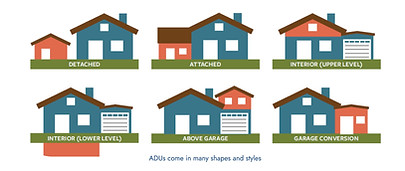PLANNING 101
Implementing Middle Housing & ADUs
Expanding housing options like duplexes, triplexes, and townhomes to support more diverse and affordable housing
Regulatory Context
The City of Airway Heights updated its zoning and development standards to comply with recent state legislation. As a Tier 3 city under HB 1110, every residentially zoned lot must allow at least two units. The City is also implementing HB 1337, which requires jurisdictions to permit two Accessory Dwelling Units per lot within Urban Growth Areas.
To meet these requirements, the City amended its residential development code to allow “either twenty-two units per acre or three units per lot, whichever results in a higher density”, in both the Neighborhood Family Residential (NFR) and Multiple-Family Residential (MFR) zones.

Comprehensive Plan Implications
The Comprehensive Plan will reflect the increased residential capacity resulting from middle housing code updates. It will also include policies and actions to support ongoing implementation, ensuring alignment between land use planning and recent state housing mandates.
What is "Middle housing"?
Middle housing means “A range of multi-unit or clustered housing types, compatible in scale & character with single family housing, such as duplexes, triplexes, townhomes, & courtyard housing.”
There are multiple benefits of introducing Middle Housing typology.
-
Promoting Inclusion: Middle housing diversifies neighborhoods, overcoming historical exclusion by offering diverse housing options.
-
Enhancing Affordability: These homes are more affordable due to lower construction and lower ongoing costs compared to single-family homes.
-
Addressing Climate Change: Middle housing has a smaller environmental footprint per unit, aiding efforts against climate change.
-
Supporting Transit and Walkability: Dense housing options promote transit use and walkable communities, reducing car dependency.
-
Preserving Natural Areas: Focusing housing in urban areas helps preserve rural lands and forests from development.
-
Meeting Housing Needs: Middle housing provides options across income levels, fulfilling new Housing Element requirements and promoting housing equity.
What is "ADU"?
Accessory Dwelling Unit (ADU) means “A dwelling unit located on the same lot as a single-family housing unit, duplex, triplex, townhome, or other housing unit.”

Benefits of incorporating Accessory Dwelling Units.
-
Diverse Housing Options: ADUs add diversity to housing choices.
-
Blend with Neighborhoods: ADUs integrate well into low-density residential areas.
-
Demographic Catering: They accommodate state’s changing demographics, including more seniors and smaller households
-
Affordability: ADUs are typically more affordable than detached single-family homes.
-
Urban Growth Efficiency: They increase housing units without expanding urban areas.
-
Inclusion: ADUs promote diversity in housing and household types in single-family neighborhoods, correcting historic exclusion.
-
Climate Impact: ADUs reduce environmental impact by using less energy than traditional single-family homes.
-
Infrastructure Use: They utilize existing infrastructure such as sewer, water, and streets.













